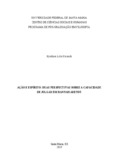| dc.creator | Palandi, Krishna Lila | |
| dc.date.accessioned | 2020-03-04T18:53:20Z | |
| dc.date.available | 2020-03-04T18:53:20Z | |
| dc.date.issued | 2019-08-30 | |
| dc.identifier.uri | http://repositorio.ufsm.br/handle/1/19729 | |
| dc.description.abstract | The present dissertation aims to determine, as closely as possible, the capacity of judgment
according to Hannah Arendt. The way she approached this ability has fluctuated over time, so
we can distinguish in her work two perspectives on this capacity. At first, Arendt addresses the
capacity of judgment under the conceptual context of his theory of action. In a second
moment, it's approached under the conceptual context of the life of the mind. This difference
in context in which the capacity of judgment is analyzed instigated the philosophical debate
that, perceiving the change of perspective of analysis, asks if there is coherence between both
perspectives. Thus, the search for determining the capacity of judgment also demands the
analysis of conceptual coherence between the mentioned approaches. Under the context of
action theory, Arendt was able to determine what the capacity of judgment is. This
determination happens when Arendt synthesizes, in the same capacity, aristotelian phronesis
with the kantian capacity to judge reflexively. However, in this context it is not possible to
clearly delimit the relationships between mind capacities among themselves, especially
between the capacities of imagining and judging. This delimitation will only be possible after
Arendt has investigated the life of the mind as a whole. Judgment in this context is described
as one of the three fundamental activities of the mind, along with thought and will, and in
close relationship with two other mind capacities, imagination and common sense. The
relationships that mind capacities establish with each other have allowed Arendt to clarify
some points that, under the context of action theory, would remain confusing, as well as
explain how judgments are made effective. The change in perspective under which the
capacity of judgment was described did not imply a conceptual split, nor the abandonment of
a prior conception over a new one. In analyzing the capacity of judgment from two
perspectives, Arendt provides a broad and coherent overview through which we can
determine, besides what is the capacity of judgment, how she judges. | eng |
| dc.description.sponsorship | Coordenação de Aperfeiçoamento de Pessoal de Nível Superior - CAPES | por |
| dc.language | por | por |
| dc.publisher | Universidade Federal de Santa Maria | por |
| dc.rights | Attribution-NonCommercial-NoDerivatives 4.0 International | * |
| dc.rights.uri | http://creativecommons.org/licenses/by-nc-nd/4.0/ | * |
| dc.subject | Capacidade de julgar | por |
| dc.subject | Reflexividade | por |
| dc.subject | Ação | por |
| dc.subject | Espírito | por |
| dc.subject | Capacity of judgment | eng |
| dc.subject | Reflexivity | eng |
| dc.subject | Action | eng |
| dc.subject | Mind | eng |
| dc.title | Ação e espírito: duas perspectivas sobre a capacidade de julgar em Hannah Arendt | por |
| dc.title.alternative | Action and spirit: two perspectives on the capacity of judgment in Hannah Arendt | eng |
| dc.type | Dissertação | por |
| dc.description.resumo | A presente dissertação visa determinar, da forma mais aproximada possível, a capacidade de
julgar segundo Hannah Arendt. O modo como ela abordou essa capacidade oscilou com o
passar do tempo, de modo que podemos distinguir, em sua obra, duas perspectivas sobre essa
capacidade. Em um primeiro momento, Arendt aborda a capacidade de julgar sob o contexto
conceitual da sua teoria da ação. Em um segundo momento, ela é abordada sob o contexto
conceitual da vida do espírito. Essa diferença de contexto em que a capacidade de julgar é
analisada instigou o debate filosófico que, percebendo a mudança de perspectiva de análise,
pergunta se há coerência entre ambas perspectivas. Dessa forma, a busca pela determinação
da capacidade de julgar demanda, também, a análise da coerência conceitual entre as
abordagens mencionadas. Sob o contexto da teoria da ação, Arendt foi capaz de determinar o
que a capacidade de julgar é. Essa determinação acontece quando Arendt sintetiza, em uma
mesma capacidade, a phronesis aristotélica com a capacidade de julgar reflexiva kantiana.
Contudo, nesse contexto não é possível delimitar de forma clara as relações entre as
capacidades espirituais entre si, principalmente entre a capacidades de imaginar e de julgar.
Essa delimitação somente será possível após Arendt investigar a vida do espírito como um
todo. A capacidade de julgar, sob esse contexto, é descrita como uma das três atividades
fundamentais do espírito, junto com o pensamento e a vontade, e em íntima relação com
outras duas capacidades espirituais, a imaginação e o sentido comum. As relações que as
capacidades espirituais estabelecem entre si permitiu a Arendt desobscurecer alguns pontos
que, sob o contexto da teoria da ação, permaneceriam confusos, além de também explicar
como os julgamentos são efetivados. A mudança de perspectiva sob a qual a capacidade de
julgar foi descrita não implicou em uma cisão conceitual, nem tampouco no abandono de uma
concepção prévia em detrimento de uma nova. Ao analisar a capacidade de julgar sob duas
perspectivas, Arendt fornece um amplo e coerente panorama através do qual podemos
determinar, além do que é a capacidade de julgar, como ela julga. | por |
| dc.contributor.advisor1 | Debona, Vilmar | |
| dc.contributor.advisor1Lattes | http://lattes.cnpq.br/5992703653122811 | por |
| dc.contributor.referee1 | Fanton, Marcos | |
| dc.contributor.referee1Lattes | http://lattes.cnpq.br/1289142079717808 | por |
| dc.contributor.referee2 | Silva, Adriano Correia | |
| dc.contributor.referee2Lattes | http://lattes.cnpq.br/7465568204123045 | por |
| dc.creator.Lattes | http://lattes.cnpq.br/0431874579549989 | por |
| dc.publisher.country | Brasil | por |
| dc.publisher.department | Filosofia | por |
| dc.publisher.initials | UFSM | por |
| dc.publisher.program | Programa de Pós-Graduação em Filosofia | por |
| dc.subject.cnpq | CNPQ::CIENCIAS HUMANAS::FILOSOFIA | por |
| dc.publisher.unidade | Centro de Ciências Sociais e Humanas | por |



